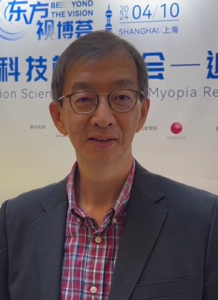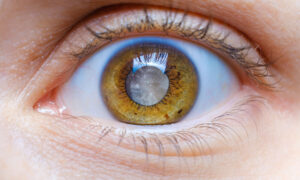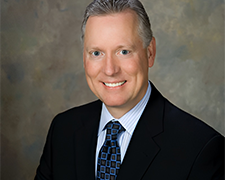May 6, 2024
While in Shanghai to attend the “Frontier in Vision Science Summit — Myopia Research,” Review of Myopia Management took the opportunity to investigate how myopia management is accomplished in China. There’s a lot to learn from a country that is not only more advanced than most in treating myopia progression among children but also in taking steps up to the highest level of government to raise awareness among the public about available treatments.
At the same time, China also has a lot to learn from its neighboring Southeast Asian countries as well as from the rest of the world. This is one of the goals of the Asian Optometric Management Academy (AOMA), to bring the model of upgrading to primary eye care already achieved in countries such as Malaysia and Singapore to independent optical practices throughout China.
In this first in a series of interviews from Review of Myopia Management’s recent tour of optometry in Shanghai, learn from the president of AOMA, Tan Kah Ooi, how China addresses myopia management and what his organization is doing to further improve access to available treatments.
Listen to or read the interview here:
RMM: Hello and welcome to the Review of Myopia Management interview series. I am John Sailer, Editor-in-Chief of Review of Myopia Management, and I am coming to you from Shanghai, China, where RMM is attending the “Frontier in Vision Science Summit – Myopia Research,” sponsored by the Asia Optometric Management Academy and Fudan University’s Eye and ENT Hospital.
We have the honor of speaking with AOMA’s Tan Kah Ooi for an in-depth interview of how myopia management is achieved in China and what his organization and others are doing to slow the progression of myopia in China and Southeast Asia.
So, I’m interested in the areas you mentioned, Malaysia, Singapore, Hong Kong, and also mainland China. That’s where we are.
AOMA: It started with the idea to try to upgrade practitioners in China from doing dispensing and refraction to primary eye care and then bringing practitioners who have gone through this transformation in the past, like practitioners in Malaysia, Singapore, and Hong Kong, to share with the practitioners in China. That’s why AOMA is set up with the objective to actually help promote this interaction between practitioners from different parts of Asian countries to leverage on their capability to share among each other.
So, that’s one part because we recognize that in order to upgrade to primary eye care, it cannot be done just simply by purchasing new equipment or instruments in a practice. For example, you bring in a fundus camera and OCT, but that doesn’t mean that you are providing primary eye care. You need more than that. Not just the hardware. You need the software, for example, the skill of the practitioner to do it and also the process of how you actually do the whole thing.
RMM: Education.
AOMA: Education, exactly.
RMM: And the education is coming from where, from the manufacturers?
AOMA: China, to a certain extent, is quite fortunate over the last five years. They actually have ramped up the education system. They have a three-year optometry program. They have a four-year optometry program. They also have a five-year optometry program. Each one can cater to different needs. So, they are able to produce a quality practitioner, a skilled practitioner who can serve at the community level or in the institution or in research. But this takes time because we’re talking about 1.4 billion people and 70,000 optical shops. The number of graduates produced in China will take time to fill the gap.
RMM: So, what’s the difference? How is myopia management specifically practiced in Malaysia, Singapore, Hong Kong, and mainland China?
AOMA: I will come to that. When AOMA was set up, it was basically talking about primary eye care to transform the model of dispensing and refraction to primary eye care or the optometry practice model, which can do primary eye care.
The objective is to transform optical practices that are doing dispensing and refraction only to the level that they can provide primary eye care, but this transition takes time. So AOMA proposes a few models that can do it step by step. For example, using the model from Malaysia and Singapore, where we can see that the practices in Malaysia and Singapore have actually gone through the traditional way of dispensing and refraction, and then they add in more skills, more processes, and also the right equipment and instruments in order to provide primary eye care. Singapore, Malaysia, and Hong Kong, have education systems to produce qualified optometrists. They also have legislation to regulate the practice of optomery, so that actually helps to facilitate the transformation. But in China, they don’t have legislation, but they have education, so they already produce quality and skilled practitioners who are able to provide these services. So, what we can do is actually bring them together to cover three main elements. One is people, qualified optometrists. Secondly is hardware, instruments and equipment. And thirdly is the protocol of the processes, how to do the proper primary eye care process.
RMM: And then also legislation.
AOMA: And legislation, but legislation is beyond our control because that’s the government. At least what we can do is put all these elements together so that they can actually start something. At least they have all the key and critical elements in place, then they can start doing these services.
Hospitals Are the Primary Source of Myopia Management in China
RMM: I’ve always been told in China that most of the eye care is in the hospitals. That’s why I asked to go to the hospitals. But I’m hearing also that there are a lot of optical shops, which I wasn’t really aware of, probably because they were only doing refractions.
AOMA: Exactly. You are absolutely right. The mainstream of these eye care services or vision care services in China is provided by two mainstream sources. One is the hospital for anything to do with red eye, burning, pain, or whatever, they go to the hospital. Most of these are public hospitals. The other one is actually more like refraction, like vision correction. They go to the optical shop for a pair of glasses, for contact lenses, glasses, nothing more than that.
RMM: So, you’re trying to change that?
AOMA: So, there’s a gap between the hospital services and the optical shop. The public hospital deals with disease and surgery, but they don’t deal too much with visual correction. The patient load is so huge, the queue time, the appointment system is very high. So, the eye doctor may actually not have time to provide proper primary eye care. So, the ophthalmologists in China recognize this problem and also want to upgrade and promote optometry to take over some of the workload, and they’re doing that. They actually train and encourage optometry so they can take over some of the workload from ophthalmologists.
RMM: So, it takes some of the load off the hospitals for things that aren’t emergencies.
AOMA: Exactly. Yeah. So, we can see that the retail optical shop now is trying to actually add in more skill-based services, first of all for their survival. Secondly, to engage patients so that they can provide more services in addition to dispensing and refraction.
RMM: So, this is key to their survival, expanding beyond refractions and correction and adding specialties like myopia management and vision therapy?
AOMA: Exactly, vision therapy and myopia management happen to be key and popular topics in China. A couple of years ago, the publications from the World Health Organization, from Nature, from the late professor Brien Holden, talking about myopia prevalence is going to hit 50% of the world population by year 2050, and 10% will end up with high myopia, and high myopia will have higher risk of ocular complications.
So, this message actually comes from the top Chinese government, they actually address that they need to bring down myopia. The key message for China is actually that the instruction comes from the top. So, the government authority or the different department like ministries of health and education are trying to put together a plan to reduce the myopia prevalence in China because in the year 2020, already 50% of the Chinese population already has high myopia.
RMM: Wow.
AOMA: It’s already there. So, along with this emerging need of myopia management, some of these optical practices thought that it’s a good idea to get involved in myopia management as well. So, they want to upgrade their skill to do myopia management, talking about optical products like spectacle lenses for myopia control, OrthoK, or soft contact lens. They don’t do atropine in the optical practices, but at least they can do optical approaches.
RMM: So, if they have the equipment and they have the education, can they just do it?
AOMA: Yes.
RMM: They don’t have to ask the government, “Can I do it? Is it okay?”
AOMA: No, they can do that. Except OrthoK. OrthoK is regulated. It can only be prescribed in the hospital setting or practices with a medical device license.
RMM: And do they use atropine in the hospitals also?
AOMA: Yes. They use atropine in the hospital.
RMM: So, they have patients coming back regularly?
AOMA: Yes, for the treatment, that’s right. In the hospital setting they can do everything, spectacle lenses, soft contact lenses, atropine, and OrthoK.
RMM: And in the shop, can they do soft contact lenses?
AOMA: They can do soft contact lenses, and they can do spectacle lenses. So at least there is something that they can offer.
About 200 Spectacle Lenses for Myopia Management!
RMM: And I understand in China there are a lot of spectacle lenses already, the major brands plus a lot of local brands.
AOMA: Yep. Since we are talking about this, I’ll share about it now. Other than the big boys, the main companies like Essilor, Hoya, Zeiss, there are some local companies that also come up with their own designs, proprietary designs for myopia control. So, right now there are about 200 different brands of myopia control spectacle lens products in China.
RMM: Wow, how does the practitioner know which one to use?
AOMA: That is the problem. That’s the problem. So, in the Tier One city, practitioners who have gone through training or attended CPE program, they know how to differentiate. They know how to actually analyze and use an evidence-based approach to pick the product.
RMM: So, it’s up to the patient to know which practitioner to choose, who knows which spectacle lens to choose.
AOMA: Exactly. But in some of the Tier Three and Tier Four cities, practitioners may not have the opportunity to attend the CPE to understand the evidence-based approach to myopia control. Then, from a marketing point of view, they just think, ‘Okay, this is from company A, B, C, and they can do myopia control,” and they just dispense it. They just market it.
RMM: And do they monitor axial length growth?
AOMA: Some of them they do, but not all of them.
RMM: And some use refraction to monitor?
AOMA: That’s right.
RMM: I’ve heard the phrase Tier One city. Is that based on population?
AOMA: Based on population and economic growth, and the definition of Tier One, Tier Two, sometimes changes from time to time, but also depending on how fast the GDP grows, et cetera. But Tier One city normally refers to a city like Beijing, Shanghai, Guangzhou, Shenzhen. All these key cities are Tier One.
RMM: And is Hong Kong considered a part of that?
AOMA: Yes, Hong Kong is considered as part of that.
RMM: So, has Hong Kong been absorbed into China?
AOMA: Yep. But they still regard Hong Kong as a separate entity because Hong Kong is a special territory. So, Hong Kong is well established in eye care and vision care.
RMM: So, Hong Kong is more similar to Malaysia and Singapore than to China?
AOMA: Yes. Exactly. Then the Tier Two city and Tier Three city depends on population and also on economic growth. So, for example, a city like Changzhou, somewhere in a two-hour drive from Shanghai, is considered a Tier Three city.
RMM: They have fewer practitioners?
AOMA: Yes, but they still have a population of millions of people. Even the Tier Three cities still have about four or five million of population. So, the challenge is myopia management is emerging, but there’s no proper legislation in optometry practice, and its complicated by the 200 different brands of myopia control spectacle lenses. So, practitioners are having difficulty understanding which one to choose, which one to prescribe.
So AOMA, other than trying to help bridge the gap for optical practices in China to upgrade to a level where they can provide primary eye care, AOMA is also trying to bring in expert clinicians who have experience in certain areas to share with practitioners in this region, especially at the optical retail level.
RMM: So, when was AOMA founded?
AOMA: The official approval date was actually 2019. So, talking about myopia management, AOMA is also trying to serve as a platform to bring in clinicians who are experienced in myopia management to share with practitioners in China. But China, talking about myopia management at the institution level, hospital level, they’re quite advanced in providing myopia management services because they are taking a holistic approach.
They’re already doing spectacle lenses, atropine, OrthoK, soft contact lenses, promoting outdoor activity in the community. They’re all doing that. But it’s only the optical shop lacking this information. They don’t have the skill to do myopia management.
RMM: So, you’re training them?
AOMA: We don’t train, but we provide a platform to have the interaction between practitioner in the country. For example, this conference here, we actually bring in the speakers from overseas and locally to share about the advances in myopia management, so that practitioners in China know what’s happening in the research area. But other than this, we are also trying to promote interaction between practitioners in China and some other south Asian country. So, a couple of months ago, AOMA organized a field trip for practitioners in China who are interested to see how the optometry model works in Southeast Asia.
So, about 20 practitioners and owners of the optical practices from China joined the field trip traveling to Kuala Lumpur, Malaysia, Hong Kong, and to visit some of the optometric practices in these countries. So, we have a clinician in this country like Malaysia and Hong Kong show them how the model works and inspire them on how the transformation requires certain elements, the ones that I mentioned earlier like technical skill, equipment, and the process. So, that was the first field trip. So, these business owners from optical practices had a chance to visit the practices in Malaysia and Hong Kong. Then they came back and can think about how they are going to transform their practices.
RMM: And are they considered optometrists? Are they called optometrists?
AOMA: Some of them are, some are not. Some of them are the business owner of the shop.
Privatization of Optical Shops in China
RMM: So that leads me to a question about ownership in China. I didn’t know people could have ownership in China. I guess they can.
AOMA: They can now. In the 1970s, most optical shops were state owned, public owned, government owned. But from 1980 onwards, you can see more and more privatization. So, from 1980 until now, most of the optical shops are private owned. So, the business owner can set up an optical practice here and can set up an optical practice somewhere else.
RMM: So, the people who worked there were able to buy it from the government?
AOMA: They start from scratch.
RMM: Cold start, we call it.
AOMA: Cold start. Yeah. Some actually buy from the government. Some optical chains like in Beijing and Shanghai used to be owned by the government, but they were acquired by private entities.
RMM: Are there chains?
AOMA: There are chains, and there are also independent optical practices as well.
RMM: Wow, I didn’t realize that. So that’s the same in a lot of businesses?
AOMA: Yep, that’s right. Privatization. Restaurants, services, even dental clinics are privatized. Eye clinics as well. Then, talking about hospitals, most of them are public hospitals. But there’s one private hospital that actually stands out. AIER Eye hospital. AIER Eye hospital is the biggest private eye hospital in China now. They have almost about 700 hospitals, and they also have about a few hundred optometry practices in the country.
So, their hospitals provide main services, and they also have optometry practices providing vision care services. They also acquired a few groups outside China. For example, in Hong Kong they acquired the Poly Vision Group. But they’re very successful because it’s one of the privatizations that’s very successful in growing the vision care segment.
RMM: So, China is evolving into private business ownership.
AOMA: It is.
RMM: I’m told that myopia management in the hospitals is a lot more expensive than myopia management in the optical shops. Is that the case?
AOMA: Not really. No. It’s actually quite cheap in the government sector. The challenge is the queue time is long. Cost is not an issue in the hospital. It’s the queue time and waiting time. They are full up. Some come from a few hundred kilometers away to come to the hospital, and then if they need to come back for after care, that is the challenge.
RMM: Somebody showed me a picture of the hospital on the weekend, and it’s full of people. But they also told me that during the week it’s empty because everybody’s in school.
AOMA: Yes, that’s right. Especially for the myopia control clinic, the weekend is packed, and on average one ophthalmologist in the hospital or one optometrist can see a few hundred of patients in a day.
RMM: Wow!
AOMA: A few hundred patients.
RMM: How can they even treat them?
AOMA: That’s right. Four minutes per patient.
RMM: And do they prescribe in those four minutes?
AOMA: Yeah, but they work as a team. So, the ophthalmologist does the main part of assessing the eye health, everything, and then they pass it to optometry to do the follow-up on recommending which approach to do the myopia control, which prescription. Then they pass to the next one, the dispensing optician to dispense the product. So, they work as a team.
RMM: All within the hospital?
AOMA: All within the hospital.
RMM: So, they have a dispensing optician in the hospital?
AOMA: Yes.
RMM: Do they have glasses and contact lenses?
AOMA: Some they do, some they don’t. If they don’t, they refer them to the outside practice to get it done. So, the model in the hospital setting in China is very different from even in Malaysia and Singapore. In Malaysia, Singapore, one practitioner sees the patient all the way through for patient management. Here in China, the patient goes through different stations. The patient comes in, a technician will check their vision, they go to the next station, some other technician will check their intraocular pressure or take the fundus photo, go the next station, and eventually go to the eye doctor. The doctor will say, “Okay, this is your finding.” Then they interpret, have a final check, and then they just do the patient management recommendation.
RMM: And when they come back, do they see the same person?
AOMA: It depends on what they need to do. They might need to repeat the whole thing, or they just go back to see the doctor alone.
RMM: So, if they have a combination OrthoK and atropine, they need to go back regularly and be monitored.
AOMA: That’s why cost is not an issue even with combination treatment, but follow-up is a challenge for them.
RMM: So, they must have biometers in the hospitals at least.
AOMA: Yes, they do.
RMM: But optical shops, some do, some don’t?
AOMA: Optical shops, most of them don’t. That’s why for those who are trying to upgrade to provide these services, they are trying to actually bring in and add biometry so that they can provide these services. So, AOMA is actually providing this platform to bring in this knowledge to share with the optical practices so they know what exactly they need to do if they want to do myopia management.
RMM: So, AOMA has sponsors, right?
AOMA: Yes.
RMM: So how does that work?
AOMA: We have to find sponsors, big companies like Essilor, CooperVision, et cetera. So, if they think that there’s something that can help grow the market then they don’t mind to sponsor. And the training, everything is very generic, not product oriented, even though it’s sponsored by the industry. But the training or the event normally is actually done in a generic approach.
RMM: Generic approach?
AOMA: Not commercial. AOMA would not be talking about product. We’re talking about the technique.
RMM: Is there a preferred modality? I know the preferred modality in the hospitals is OrthoK and/or atropine. In optical shops?
AOMA: In the optical shops, spectacle lenses, because that’s the easiest and also the most acceptable option among the public.
RMM: So, even if it’s one of the 200 brands that’s not effective, at least you’re not harming the child’s eyes probably with maybe something dangerous like poorly compounded atropine or something like that? Just spectacle lens. So, you need to educate the practitioner on which is the better spectacle lens.
AOMA: Exactly, so evidence based is one of the key approaches that we share with practitioners. If they want to do myopia management, it has to be evidence based, because out of 200-odd brands, very few of them have the proper design, and very few of them have a clinical study to support their efficacy. The rest don’t even have clinical efficacy data. They just copy the product, copy the design, and they just launch it claiming that it’s the same efficacy. But some practitioners don’t know how to differentiate. They dispense it, and the patient depends on the practitioner recommendation.
RMM: And there are a lot of practitioners to educate. How many did you say?
AOMA: 70,000 optical shops. The numbers keep changing, but it’s between 70,000 and 80,000 big and small optical shops.
But the main modality for myopia control is still OrthoK as a mainstream in the hospital setting, because most parents still trust bringing the kid to the hospital, either the public hospital or the private hospital. So, AIER Eye Hospital as a private hospital sees a lot of children for myopia control. They fit a lot of OrthoK lenses. They dispensed about one million OrthoK lenses last year.
RMM: And what about those brands? What brands are they using?
AOMA: Yeah, OrthoK, because it’s a regulated medical device, the OrthoK products on the market in China have to go through China FDA approval. So, only those approved products can be launched in China.
RMM: So, they have domestically manufactured OrthoK, and they have others from overseas?
AOMA: Exactly, CRT, GPS, Euclid, and also local brands. There are two main local brands that are doing quite well, and they are also supported by evidence-based clinical trials.
RMM: And they have the time in the four minutes to customize the lens?
AOMA: For this one, it’s done by the ophthalmologist in the special clinic. So, the four minutes are for the general examination. Then when they think there’s a need, they refer for a special follow-up session to do the OrthoK fitting, training, instruction, et cetera.
RMM: So, what percentage of patients are being treated in the hospital?
AOMA: I’m not quite sure about the exact number, but so far the majority of myopia control is with OrthoK, definitely almost 100% from the hospital, and atropine. So OrthoK and atropine are all from the hospital.
RMM: You said the shops cannot do OrthoK and they cannot do atropine.
AOMA: Yes, that’s right. Then spectacle lenses, maybe 90% is from the optical shop. When a patient goes to the hospital, normally they are recommended for OrthoK or atropine or to a certain extent maybe spectacle lenses or soft lenses. But most patient’s preference is actually OrthoK because they know that after overnight wear they can move around without glasses. It’s more convenient, so most parents like that.
RMM: It’s very similar to the United States with ophthalmologists prescribing OrthoK and atropine and optometrists prescribing spectacle lenses and contact lenses. But optometrists also do OrthoK because they’re allowed to in the U.S.
AOMA: Optometrists in Singapore, Malaysia, and Hong Kong prescribe a lot of OrthoK.
RMM: Is that a goal for China?
AOMA: That’s a goal, partly because Hong Kong, Malaysia, and Singapore are regulated markets. Only optometrists are qualified to prescribe all these different optical devices, including OrthoK. So, they choose OrthoK, partly because of the preference from parents that they don’t need to wear glasses the next day. But in China, their regulations state that only the hospital sector can prescribe OrthoK.
RMM: And that’s not going to change?
AOMA: That’s not going to change in the very near future. Probably they will, but not in the near future. So, OrthoK is mainly done by ophthalmologists and optometrists in the hospital.
RMM: So, are you working in Singapore and Malaysia and Hong Kong also to promote the expansion of myopia management, or are you bringing that to China?
AOMA: We’re bringing that to China.
RMM: That’s the goal of AOMA?
AOMA: Yes, for the myopia program. This is a voluntary job. We are not paid to do it. We don’t work for AOMA. AOMA is a nonprofit organization. We bring in those like-minded practitioners to come together to work on a voluntary basis to help promote the optometry profession.
Myopia Management Awareness is High in China
RMM: Wow, that’s nice of you. Just like GMAC in the United States, the Global Myopia Awareness Coalition. It’s all voluntary and it’s all about raising awareness among patients, actually. So, what’s the awareness level among patients and parents in China?
AOMA: To our surprise, the awareness of myopia is actually quite high in China. Partly because the advocacy effort from the government is actually quite good. From the top government officer all the way to the ground level, they manage to convey the key measures that myopia needs to be controlled. So, most parents know about myopia complications. So, they’re actually trying to seek treatment or prevention to prevent their kid from becoming a high myope.
RMM: Is that because of word of mouth?
AOMA: Word mouth, in the media, and in school. Some of the schools you visit in Shanghai, you can see that there’s a signboard saying, “myopia blah blah blah.” So, the advocacy effort in China to the public is considered quite good. But we are talking about 1.4 billion people, so not every corner will get that. But if we compare this to Singapore, Malaysia, here the public awareness is better.
RMM: Better than the United States. In the United States we’re raising awareness because it needs to be raised, but they still need to learn. We’re raising awareness among practitioners and among patients at the same time.
AOMA: Even some parents in China try to go online to buy atropine. “Atropine works, so let’s go online and buy it.” Of course, it’s regulated. You cannot buy online.
RMM: Well, that’s good.
AOMA: But this is the mentality of parents. They say, “Okay, let’s try anything that is possible to control myopia.”
RMM: What percentage atropine are they using in the hospitals?
AOMA: They used to use 0.01%, but now with more literature showing that 0.01% may not be effective against axial length elongation, so they’re changing to 0.025% and 0.05%, or the 0.01% is a combined treatment with OrthoK or with some other treatment.
RMM: So, if this is voluntary for you, what is your background?
AOMA: I work for nthalmic. It is a new research company based in Australia in Sydney. We formed this company in Sydney in August 2019.
So, we are not here to impose what you should do. The clinicians from Southeast Asia are here to share what they have gone through. Then, if that inspires the practitioner or business owner in China, then AOMA can serve as a platform to connect them together to share, to continue to deepen the relationship. And then they can either fly to Malaysia and Singapore to look at the model, or we can arrange to fly the clinician to China to look at their practice and share with them how to actually transform or change.
RMM: Wow, that’s great. So, teach by example.
AOMA: Teach by example, and why? Actually, the ultimate goal is to have a model similar to what we have in the U.S, the OD clinic, the optometry clinic in the U.S. That’s the ultimate goal because the doctor of optometry in the U.S. can do primary eye care. But for the practitioner in China or Asia, to aim to upgrade to the model in the U.S. is too far. It’s too far out of their reach. It’s not easy for them to transform from the current optical practice to the doctor of optometry clinic like the U.S.
RMM: Well, that took many years in the U.S. also. It took optometrists to create legislation.
AOMA: Exactly, we are talking about late 20th century, the U.S. already had the legislation, but here it’s not.
RMM: And they legislate, they negotiate with the government to have laws changed, but here it’s a different story?
AOMA: Here it’s a different story. So, what we thought is actually more practical is to take the model from Southeast Asia so that they can do step by step. Because over 20/30 years ago in Malaysia, the optical practice was exactly the same as what we can see in China now. They only do dispensing, refraction, that’s it, nothing else. But with the education system established in Malaysia in 1984, I was the fourth batch of optometry students in Malaysia. During that time there was only one university with an optometry program.
RMM: Wow. Congratulations.
AOMA: We had support from Australia to establish the program. So, after 1980, most of the practices in Malaysia tried to transform to provide primary eye care. So, we have seen that transformation over the last 30 years. So, we thought that that is a good learning journey we can share with China. It’s not something that we can change overnight, but it takes time.
RMM: That’s great. You should be commended for your service.
AOMA: So, AOMA, the main job is actually done by the whole team. I’m just here to help to put things together and then engage the practitioner from Southeast Asia, Hong Kong, even Australia, to share the experience with the practitioners in China.
And AOMA is also working with AOC, Asia Optometric Congress. So, AOC is another non-profit organization registered in Singapore.
So, right now in Asia there are only five places with legislation — Philippines, Malaysia, Singapore, Hong Kong, India. Only these five places, so the rest are still a work in progress.
One more thing about China is about the service provider, mainly the hospital and the optical shop, but optical shops at this level are not able to provide primary eye care. So, what the stakeholder hopes to achieve is to have what we call community optometrists because that is very common in Hong Kong, Singapore, and Malaysia. You walk on the street in the housing area, and you can see optometry practice there in the neighborhood, very easy access. But in China, in the neighborhood area, it’s only optical shops. There’s no optometry, so we hope that through this we can actually bring in more community optometry practices in China.
Otherwise, those people who are living a hundred kilometers away from the hospital, there’s no way they can go to hospital every day or for follow-up. So, if they have a community optometrist in the small town, they can get access to it.
We are talking about the existing optical shop practice.
RMM: So, they’re already there?
AOMA: They’re already there, but if they can upgrade then they can actually provide better services and then they can be the community practice.
RMM: So, they’re already there providing dispensing and refraction services, and they need to be elevated to primary eye care?
AOMA: And then coming back to the main theme for Review of Myopia Management, we hope that through this more and more practices are able to provide myopia management services, and then they can help to actually reduce the prevalence of myopia or prevent children from becoming high myopes.
RMM: That’s the ultimate goal?
AOMA: Yes, the ultimate goal.
RMM: To stop the incidence of it?
AOMA: Exactly. Yeah. So, AOC focuses mainly on the country level. AOC only has about 13 members from the ASEAN countries, China, Korea, and India. So, the membership is actually based on the country. Whereas AOMA, membership is based on practices or individuals. So, these are two different nonprofit organizations, but one is actually more for the optometry practices, which is AOMA. Whereas AOC is more about helping the country to establish legislation, education system, and expand the scope practice.
AOC is organizing the myopia management Attitude Project. The Myopia Management Attitude project is a perception of market project we initiated two years ago to interview practitioners in Asia about what are the challenges and barriers they face when they do myopia management. It’s an AOC project that AOMA also helped to support. This project had been presented at the Academy and also at the BCLA, so I can share some of this information with you. We interview practitioners face-to-face virtually for up to 45 minutes to understand what they face when they do myopia management. For example, financial costs, public awareness, confidence in the practitioner, the parents, and so on. So, we identified some of the team, and then we share and then hopefully we can embark on some program to help them to overcome this barrier. We already interviewed over one hundred practitioners.
So, we have done practitioners from Malaysia, Singapore, Philippines, Vietnam, Hong Kong, and Thailand. In China, we already interviewed 38 practitioners, but we are going to do combine with some other survey as well.














